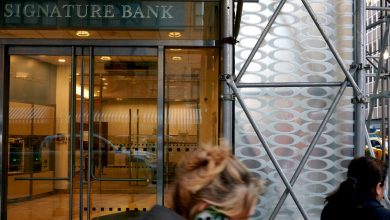‘Lost Time for No Reason’: How Driverless Taxis Are Stressing Cities

Around 2 a.m. on March 19, Adam Wood, a San Francisco firefighter on duty, received a 911 call and raced to the city’s Mission neighborhood to help a male who was having a medical emergency. After loading the patient into an ambulance, a black-and-white car pulled up and blocked the path.
It was a driverless vehicle operated by Waymo, an autonomous car company that Google’s parent, Alphabet, owned. With no human driver to instruct to move out of the way, Mr. Wood spoke through a device in the car to a remote operator, who said someone would come take the vehicle away.
Instead, another autonomous Waymo car arrived and blocked the other side of the street, Mr. Wood said. The ambulance was finally able to leave after being forced to back up, and the patient, who was not in critical condition, made it to the hospital. But the self-driving cars added seven minutes to the emergency response, he said.
“All that was lost time for no reason,” Mr. Wood, 55, said.
His experience was a sign of how self-driving taxis are increasingly starting to take a toll on city services. In San Francisco and Austin, Texas, where passengers can hail autonomous vehicles, the cars have slowed down emergency response times, caused accidents, increased congestion and added to the workloads of local officials, said police officers, firefighters and other city employees.
In San Francisco, more than 600 self-driving vehicle incidents were documented from June 2022 to June 2023, according to the city’s Municipal Transportation Agency. After one episode where a driverless car from Cruise, a subsidiary of General Motors, ran over and dragged a pedestrian, California regulators ordered the company to suspend its service last month. Kyle Vogt, Cruise’s chief executive, resigned on Sunday.
In Austin, city officials said there were 52 autonomous car incidents from July 8 to Oct. 24, including a first-of-its-kind crash by a prototype robotaxi with no steering wheel into a “small electrical building.”
To handle the fallout, San Francisco has designated at least one city employee to work on autonomous car policies and asked two transportation agencies to compile and manage a database of incidents based on 911 calls, social media posts and employee reports. This summer, Austin also formed an internal task force to help log driverless vehicle incidents.
“A lot of people on the task force are juggling this as well as other normal day-to-day operations,” said Matthew McElearney, a training captain at the Austin Fire Department. “In my job description, it doesn’t say ‘a task force member.’”
San Francisco and Austin offer a preview of what to expect in other places. While self-driving cars have been tested in more than two dozen U.S. cities over the years, those trials have moved into a newer phase where human drivers — who once rode along on autonomous vehicle rides — no longer stay in the cars during rides. Waymo and Cruise then started offering fully driverless taxi services in some cities with those cars.
Cruise has since suspended its autonomous vehicle operations. But Waymo and others continue developing and testing their cars in potential markets and the technology will spread, said Bryant Walker Smith, a University of South Carolina professor who has advised the federal government on automated driving.
Cruise had tested its driverless taxis in San Francisco, Austin and Phoenix and planned to expand to Houston, Dallas and Miami. Waymo, which provides driverless rides in Phoenix and San Francisco, said it would next roll out its services in Los Angeles and Austin. Zoox, another self-driving car company, said it planned to introduce robotaxis in San Francisco and Las Vegas but did not provide a time frame.
Other cities where self-driving cars have been tested are preparing for when robotaxis are fully deployed. The Nashville Fire Department said it was creating an annual training for firefighters about the cars. Seattle’s Fire Department said it had added safety issues with driverless cars to the responsibilities of an employee during each shift.
Some cities said their experience with robotaxis had been smoother. Kate Gallego, the mayor of Phoenix, where Waymo has run autonomous taxi services since 2020, said the company met extensively with local officials and conducted safety tests before deploying a fleet of 200 vehicles to locations including the airport.
“Our residents have generally really appreciated this service,” she said.
Waymo, Cruise and Zoox said they had worked closely with officials in many cities and continued to improve their vehicles to minimize the effects on local services. Waymo added that it had “no evidence of our vehicles blocking an ambulance” on March 19 in San Francisco.
Few cities have grappled more with self-driving cars than San Francisco. Google, whose headquarters are in nearby Silicon Valley, began testing driverless vehicles in the city in 2009 and introduced robotaxi services in November 2022. Cruise, founded in San Francisco in 2013, started testing its vehicles on the city’s roads in 2015 and offered its first driverless ride to passengers in February 2022.
Hundreds of the cars have since wound their way through San Francisco streets. At one point, Waymo had 250 driverless vehicles in the city, while Cruise had 300 out during the day and 100 at night. Residents frequently saw the cars — sedans equipped with more than a dozen cameras and high-tech sensors, some spinning on their roofs — driving by.
In July 2018, the city’s Municipal Transportation Agency asked Julia Friedlander, a transportation policy veteran, to work on understanding how San Francisco would be affected by self-driving cars. She met with autonomous car companies and state regulators, who issue permits to the companies for testing and operating their vehicles, to discuss the city’s concerns about safety and congestion.
After five years, there are still no systematic state safety and incident reporting standards for driverless cars in California, Ms. Friedlander said. “This is such a dramatic kind of change in transportation that it’s going to take many years for the regulatory structure to really be finalized,” she said.
Last year, the number of 911 calls from San Francisco residents about robotaxis began rising, city officials said. In one three-month period, 28 incidents were reported, according to a letter that city officials sent to the National Highway Traffic Safety Administration.
By June, autonomous car incidents in San Francisco had risen to such a “concerning level” that the city’s Fire Department created a separate autonomous vehicle incident form, said Darius Luttropp, a deputy chief of the department. As of Oct. 15, 87 incidents had been recorded with the form.
“We move forward with expectations that this wonder technology will operate like a human driver,” Mr. Luttropp said. “That did not turn out to be the case.”
Mr. Wood, the firefighter, attended a weeklong training session held by Waymo in June at the Fire Department’s training center to learn more about the self-driving vehicles. But he said he was disappointed.
“None of us walked away from the training with any way to get a stalled car to move,” he said, adding that manually taking over the car takes 10 minutes, which is too long in an emergency.
His main takeaway was that he should bang on the car’s window or tap on its door so he could talk to the vehicle’s remote operator, he said. The operator would then try to remotely re-engage the vehicle or send someone to manually override it, he said.
Waymo said it had rolled out a software update to its cars in October that would let firefighters and other authorities take control of the vehicles within seconds.
After the California Public Utilities Commission, a state regulator, voted in August to allow an expansion of robotaxi services in San Francisco, Waymo and Cruise started meeting every two weeks with the city’s fire, police and emergency management departments.
Jeanine Nicholson, San Francisco’s fire chief, said her department was now at a “decent place” with the companies and added that Cruise’s suspension offered more time to work out issues with the cars in emergency situations. But she anticipated more meetings and adjustments as other self-driving companies moved in.
“Time is going to be taken up, and we have a whole fire department — a whole city — to run,” Ms. Nicholson said.




